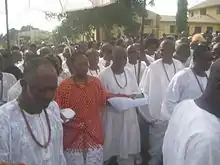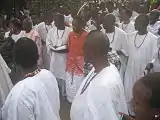Igogo festival
The Igogo festival is a Yoruba festival held in Owo, Nigeria. It is held annually in September to honor Queen Oronsen, a mythical wife of Rerengejen.[1] During the festival, the incumbent Olowo of Owo and high chiefs of Owo Kingdom dress like women with coral beads, beaded gowns and plaited hair.[2] Wearing of headgears and caps as well as beating of drums and firing of guns are not allowed during the festival.[3]
| Igogo Festival Odun Igogo | |
|---|---|
 Portrait of late Folagbade Olateru Olagbegi III, the Olowo of Owo (1999-2019), during the 2013 Igogo festival | |
| Status | active |
| Genre | Festivals |
| Begins | September |
| Ends | October |
| Frequency | Annually |
| Years active | 1601 AD – present |
| Founder | Queen Oronsen |
| Previous event | September 2014 |
| Next event | September 2015 |
| Area | Nigeria |
| Leader | Olowo of Owo |
| Organised by | People of Owo Kingdom |
| Sponsor | Olowo of Owo, Ojomo Oluda, Owo Chiefs and Owo Sons and daughters |
History
The Igogo festival began over 600 years ago during the reign of Olowo Rerengejen. The monarch married Oronsen, a beautiful and affluent queen who was, unknown to the king, an orisha. She enriched the monarch and she was loved by him as a result. Queen Oronsen insisted on certain taboos. She insisted that nobody should grind okra in her presence or pour water into the yard. In addition, anyone arriving from the farm must not lump a load of firewood. King Rerengejen cautioned his other wives not to carry out any of these activities.[4] One day, Queen Oronsen had a disagreement with the other wives of the King. They conspired against her with the intention of violating her taboos while Rerengejen was not in the palace. Her taboos were duly violated and she subsequently left the palace.[5]
While she was running out of the palace, some palace guards and chiefs ran after her to bring her back, an effort that proved futile. She later felt tired and waited at a place called "Ugbo Laja" where she was found and persuaded to return to the palace. Her refusal frustrated the guards, who forcefully captured her thereafter but she disappeared into "Igbo Oluwa", now a sacred forest, leaving her head ties (oja) at Ugbo Laja. The guards later returned them to King Rerengejen. "Ugbo Laja" is now a sacred grove. Queen Oronsen's terra cotta sculptured image from "Igbo Oluwa" by Ekpo Eyo stood at a distance to inform the Owo people that nothing will bring her back to the palace but that annually they should always sacrifice two hundred items of different articles, such as dried fish, colanut, aligator pepper, bitter cola and many more for ritual (Igogo) and in return she promised to protect the kingdom forever.[6]
Events
Igogo festival lasts for 17 days and begins with Upeli proceedings by the Iloro chiefs. The chiefs are led by a chief known as Akowa of Iloro, who is the traditional head of the Iloro chiefs.[5] This Upeli procession lasts for 12 days and features several activities including Utegi, Ugbabo, Uyanna and Ugbate.[7] It is also a period for the celebration of new yams.[8][9] During this procession, beating of drums by individuals or associations is forbidden and the use of caps by men and head ties by women at close range to the Owo monarch, the Olowo of Owo, is also prohibited. The festival features the dance of bare-chested men, the Iloro Quarter men called Ighares. They often wear white caps with two horns of buffalo in their hands. They strike these horns together while dancing around the town and visiting some sacred places in the town. During this rite, any animal that crosses their paths automatically becomes food for them. The chiefs plait their hair and dance round the town, and visit their loved ones who give them gifts in return. The monarch often dresses like a woman and dances round the town as well. Dancing in the market by the monarch is also one of the rites performed during the festival.[5]
Gallery
 The Olowo of Owo on his way to "Igbo Laja" during the 2013 Igogo festival
The Olowo of Owo on his way to "Igbo Laja" during the 2013 Igogo festival HRM Folagbade stepping out of the Palace to pay homage to Queen Oronsen during the 2013 Igogo festival
HRM Folagbade stepping out of the Palace to pay homage to Queen Oronsen during the 2013 Igogo festival Prince Orimadegun Aragun Ogunoye and Chief Oronbato of Igboroko Quarter during the 2013 Igogo festival
Prince Orimadegun Aragun Ogunoye and Chief Oronbato of Igboroko Quarter during the 2013 Igogo festival
References
- "Festivals". www.owo-kingdom.net. Archived from the original on February 10, 2016. Retrieved April 14, 2016.
- "A visit to Owo". Daily Trust. Archived from the original on August 11, 2016. Retrieved April 14, 2016.
- "Igogo festival begins". Nigerian Tribune Newspaper. Archived from the original on April 25, 2016. Retrieved April 14, 2016.
- "Owo Celebrates Igogo Festival". The Nation Newspaper. Retrieved April 14, 2016.
- Taiwo (April 15, 2016). "Spectacle as Owo celebrates Igogo festival". The Nation Newspaper. Retrieved September 30, 2015.
- Elisabeth Benard; Beverly Moon (21 September 2000). Goddesses Who Rule. Oxford University Press. pp. 125–. ISBN 978-0-19-535294-8.
- "Owo stops beating of drums, shooting of guns for Igogo". The Nation Newspaper. Archived from the original on March 4, 2016. Retrieved April 14, 2016.
- Poynor, Robin (1987). Ako Figures of Owo and Second Burials in Southern Nigeria. Coleman African Studies Center. p. 86.
- "Traditional rulers can end insurgency". The Hope Newspaper. Retrieved April 20, 2015.